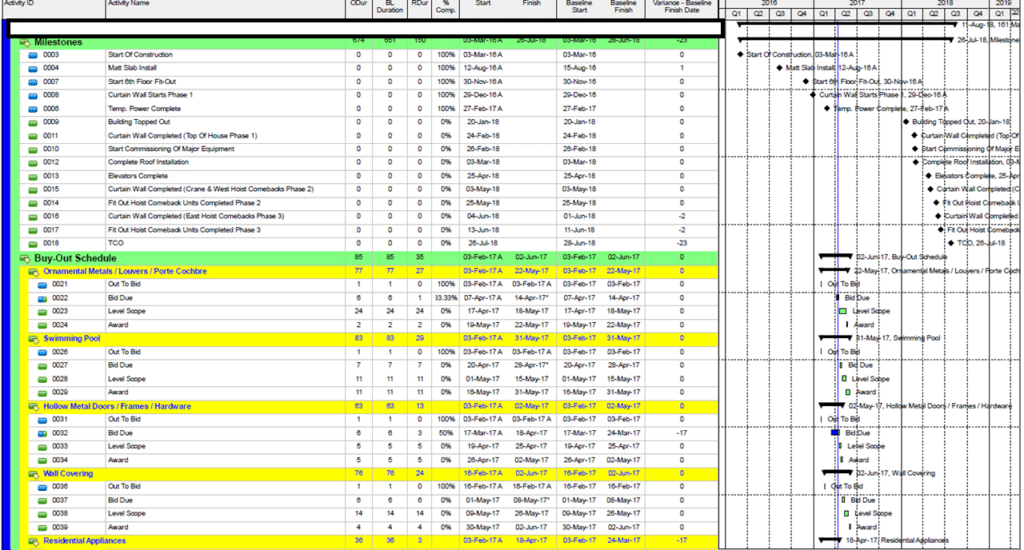Impact Schedule Overview: Managing Schedule Disruption
CPM schedule disruption is represented by an impact schedule to show deviations from the baseline schedule. Typically, it is a natural function or progression of progress updates. For example, if the schedule was impacted in a given time-frame, that impact would be captured beginning with the respective time-frame update in which it occurred, and seen through its complete cycle.
The impact schedule can represent delays, CPM schedule disruption, or both. It is incumbent on the claims manager to make that distinction. An impact schedule is predicated on a series or succession of events that are expected to increase overall duration or the critical path. In some cases the impact schedule reflects a reduction in overall duration. Such a document may accompany a claim for early completion, which may be compensable.
An impact schedule shall record an event or network of events that impact the baseline sequence of operations by adding additional steps or activities that are expected to extend the critical path. Unlike a delay, which generally has known start and end dates, it is typically not possible to know the final overall impact of a given schedule disruption until it is concluded. For that reason, an open-ended notice of delay (NOD) will accompany or be issued prior to a given update.
Impacted schedules may have more than one impact sequences that occupy different float-paths. For that reason, they must be monitored and tracked separately. Subcontractors may also issue NODs and Extension of Time (EOT) claims, which is why it’s important for the CM or GC to organize each impact as an isolated phenomenon. It also helps to reduce concurrency.
Impact schedules are not the same as an EOT or delay/schedule disruption claim schedules, though they are one of several components. Typically, an EOT for the minimum expected impact will accompany the impact schedule. At such time, an accounting of the costs associated with the delay are not calculated, as the full impact of the delay has not been completed. The claim schedule may include all critical paths, as well as accompanying cost factors.
Owners and specifiers often will indicate in the project specifications, or in their contracts, the process by which CPM Schedule disruptions are presented and reviewed. They may also stipulate compensation. There is no standard for such language. Accordingly, a great deal of language in the specifications or contract may turn out to be unenforceable or not legally binding, often merely as an obstacle. It is the bailiwick of a seasoned construction attorney to make the distinction.
Mitigation & Recovery
As impacts are realized, ownership may insist on an impact or recovery plan. Such plans are most effective when the full impact is a known quantity, and the resources and productivity associated with the impact is measured. Open-ended recovery is the typical de facto tool of choice, as contractors typically don’t maintain accurate productivity calculations. In open ended recovery efforts, resources are supplemented or assigned additional responsibilities without knowing how effective such measures will enfold. Naturally, a lot of capital can be wasted in such recovery efforts, monies stakeholders are reluctant to bankroll when they know much of the effort was unnecessary, or produced no recovery.
Mitigation refers to optimizing future sequences so to minimize or negate anticipated subsequent or exacerbated impact based on lessons-learned and measured-mile. Recovery also is intended to minimize subsequent impact, however, it infers that there already is an impact, and that the impact is expected to continue. In both mitigation and recovery, resequencing may be employed, or more likely acceleration achieved by increasing work-forces. The specific data and costs of such acceleration must be carefully maintained for acceleration claim issuance.
Impact Schedule Action Plan Overview
Diligent recordkeeping is a function of efficient impact schedule and claim management. It’s a determinant in the overall claim integrity and its likelihood, for being recognized, and an EOT granted. When recordkeeping is timely and robust, a proper Time Impact Analysis (TIA) can be made. The TIA has a far higher rate of success in the court systems than other claim methods. When recordkeeping is subpar, the TIA will carry less authority, and alternative methods or approaches may be warranted.
Insofar as timing, it is important to issue the proper paperwork at the proper time. These records will accompany the forensics as background or impetus for the impact. For example, the initial recognition of the impact must be documented and contractual parties apprised. In cases where the documentation is not timely, parties may move not honor the impact assessment.
Impact Schedule General Action Plan
Recognition: an impact typically refers to a deviation in plan in the field or as a consequence of a designer impact. This deviation should be recorded and documented as early as possible with time-stamped photographs and notifications. These documents will later accompany your claim. Any impact should be represented in the update in which it initiated, and continue through its termination.
Background Documentation: a field condition impact should necessitate a request for information (RFI) or notice of divergent or unforeseen conditions. The same is true of latent design errors and omissions. Note that designers carry errors and omissions (E&O) insurance to indemnify themselves against such claims. These actions will be recorded in the progress update schedule as a fragnet, or superimposed path, that sandwiches between two or more baseline or previously posted activities.
Coordination: as impacts occur and carry forth into later contractual periods, they must be tracked as individual phenomenon. Even so, it is inevitable that concurrent delays will occur, albeit not always self-evident. Concurrent delays must be recognized and apportioned in such a way that it is clear which are redundant, and which are not. Claims with concurrent delays are high risk of rejection out-of-hand.
Preparation: the EOT should be registered as early as possible. Failure to do so may complicate and compromise the impact of your claim. Gaps in background information, such as missing updates, or updates with flawed logic, will considerably reduce the integrity of any given claim. That is why preparation is an ongoing event, from NOD all the way through completion of each impact cycle. As each respective cycle completes, best practice dictates that you notify the owner, and advise that the EOT is complete for that cycle, and that a claim may follow.
Review & Negotiation: The low-rate of success for EOT in the courts – and especially compensable EOT claims, is why each must include the optimal effort of prosecution. When proper EOTs are registered, there is less likelihood for rejection and litigation. Incomplete claims may be defeated before they have a chance to be considered as matters for litigation, regardless of presumed entitlement.
Impact Schedule Action Plan Process
Recognition: NODs, photographs, RFIs, meeting minutes, sketches, shop drawing logs, daily reports, emails, etc., are part and parcel of the initial notification process for each impact. At such time the nature of the impact should be determined – schedule disruption or delay. A delay is simpler to capture, as it typically represents a downtime window easily represented in a start-to-finish fragnet, with no productivity losses. Schedule disruption can be more difficult to represent because it refers to a loss of production. If the impact is disruption, the applicant must maintain records of the baseline production rates, rates before the disruption, and rates subsequent.
Disruption claims are vulnerable to challenge as builders seldom maintain robust productivity rate records. The baseline production rate may also be challenged if it was not calculated accurately. For example, if an impacted activity takes 60 days instead of a 20 day baseline duration, it is not a fait accompli that there is a 300% impact if the baseline duration is determined to have been underestimated.
Background: in addition to the above, any claim will include all periodic schedule updates and narratives. The critical path updates are the basis of any delay or schedule disruption claim. Each update should be compiled with the background documentation germane to the respective updates.
In addition to GANTT charts, other documentation should inform the claim. S curves and Earned Value Analysis (EVA) are used to show actual rates of production as compared to the baseline. Software, such as Deltek Acumen Fuse and Accelerator, will generate Executive Briefs, forensics, and metrics, all of which are an enhanced level of claim preparation not available in stand-alone CPM scheduling platforms.
Coordination: each claim has its genesis in a series of events and represented through background documentation that will inform the impact schedule. The process begins with the issuance of the background from the contractor to the claims preparer. The initial transaction should be as meticulously indexed and articulated as possible for the claims manager to realize the maximum benefit. When background is piecemeal, slipshod, or incomplete, the claim integrity will suffer.
As part of the process, best practice dictates retaining a construction attorney to represent your claim, even if litigation is not guaranteed. Employing an attorney in this way lets opposing know that you are serious, and that you are prepare to defend rebuttal and challenges. Non-construction attorneys are less experienced in such matters and will require more hand-holding. That should not necessarily disqualify them from representation, but it will affect your outgo of legal expenses.
As the preparer processes the background information, he will have further clarifications and discussions to make with the contractor, typically requesting additional background. Diligent contractors who maintain comprehensive documentation will realize the maximum claim benefit. In other cases, alternative methods can be employed, which are discussed below.
Preparation: as stated above, any progress update may represent impact, however, ‘impact schedule’ should not be conflated with ‘claim schedule.’ An impact schedule is but one snapshot of the overall timeline, whereas a claim will be accompanied by all progress/impact schedules. The claim will consist of forensics and analysis components:
Forensics: historical records of overall schedule progression by activity and float path, as well as critical path of baseline and updates.
Analysis: a narrative of impacted activities detailing their nature and cause and effect relationship of successor activities and paths. Once the forensics and analysis modules are completed, an executive brief will be issued accompanied by an accounting of the impact in time and cost.
Issuance, Review & Negotiation: the issuance and review criteria may be iterated in the contract. Public and government agencies use standardized language that a contractor should familiarize himself with, as should his legal counselor. Owing to experience, this language tends to be intractable in the face of contention.
The reviewer may be an agency, the owner himself, his claims specialist, or his attorney. Larger entities typically have inhouse attorneys on retainer for this and other legal purposes. This distinction should not dictate the nature and disposition of your claim. Larger entities and government agencies often bully their contractors with contractual language, threatening memos, and may make unreasonable demands. These actions do not necessarily denote an action by the claimant, and are often intended to deflect.
The review process may or may not include opposing counsel, but it should include your attorney, if only to apprise him. It is expected that there will be push-back from the reviewer, and that additional drafts of the claim may be mandated. If these demands are within reason and contract then they should be observed, otherwise given due consideration.
Even in clear cut cases of delay or schedule disruption, contractors tend to be a bit feckless at producing the requisite background. A delay claim can then be denied for lack of due diligence by the contractor – typically an absence of supporting documentation. Thus it is important to realize that should the claim go to litigation, a higher level of scrutiny will be taken in which your background documentation must be up to snuff, i.e., accurate and relevant. Indeed, owners and agencies will challenge legitimate claims they know don’t include compelling background, because they can easily defeat them in litigation.
Impact Schedule Action Plan: Complex Claims
Large projects with a lot of moving parts and multiple primes are subject to be complicated. As the project develops, numerous impacts may be realized that involve several contractors, some of which may file their own claim. For this reason it is important to have the ability to isolate impacts by trade.
The inevitability of concurrency must be observed. Concurrent delays are when several smaller delays comprise one or more primary delay paths. They must be isolated into distinct entities to avoid being challenged and refuted. There is a growing and substantial body of legal findings on concurrent delays that the courts set store by. It is important to be familiar with the most important, as well as most recent findings.
Contractors who are handicapped by an absence of documentation will realize a low-rate of granted EOT and EOT compensation. However, that doesn’t mean they can’t stake a claim. A good claims captain can guide a contractor, and together they can reconstruct the chain of events in much the same way a detective might. Complete absence of documentation is rare, so there is always some basis to work with.
In cases where documentation is lacking, a TIA will not be an option. Other methods, such as measured mile, industry standards, et al., may be employed. These secondary methods generally produce less compelling results than a proper TIA
Impact Schedule Action Plan Review & Outline
Recognize, document, and notify ownership. Begin identifying supporting documentation.
Track overall impact to critical path in progress updates and narratives and issue tracked schedule (current and baseline).
Quantify and document costs of lost production and increased rate for recovery production. Maintain these for future integration into claim schedule.
As each impact concludes, notify owner with documentation of EOT impact. If you have calculated costs you which to claim, include them as well, though they need not be completed by such time. Once the overall impact is concluded, a complete claim with EOT and costs can be generated.
Claims for EOT and compensation must be negotiated. Be prepared with comprehensive, organized documentation. Opposing often will hedge their bets commensurate with the quality of documentation being issued. At this time, your attorney may or may not be involved in the negotiation process, but he should be aware of it.
Most claims that go to litigation are lost by the claimant, for the reasons stated above. However, most awarded claims do not go to litigation, and are a factor of a settlement in or out of mediation. That means if you follow due diligence measures and best recordkeeping practices, you stand less of a chance of litigation, and more likelihood of a granted EOT and/or compensation.
Impact Schedule Basics
Educate yourself as to the nature and specifics of your predicament, and how such matters are negotiated and prosecuted.
Be prepared for delay or schedule disruption before it happens by having programs in place to address them
Maintain scrupulous records of all scheduling data, as well as baseline, actual, and impacted production rate. Monitor and QA the veracity and integrity of your background data
Familiarize yourself with the contract stipulations. Retain an attorney as needed
Assign resources and define parameters for continual tracking and recording of impacts
Organize your comprehensive background so that it can be presented in a professional manner.










